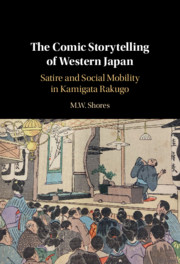Book contents
- The Comic Storytelling of Western Japan
- Frontispiece
- The Comic Storytelling of Western Japan
- Copyright page
- Contents
- Illustrations
- Author’s Preface: COVID-19 and Tenugui Face Masks
- Acknowledgments
- A Note on Romanization and Conventions
- A Note on the Cover Art
- Introduction
- Part I
- Chapter 1 Kamigata, Osaka
- Chapter 2 The History of Kamigata Rakugo
- Chapter 3 What Constitutes a Kamigata Rakugo Story?
- Chapter 4 Geidan: An Interview with Hayashiya Somemaru IV (b. 1949)
- Conclusion
- Part II
- Book part
- Bibliography
- Index
Chapter 2 - The History of Kamigata Rakugo
from Part I
Published online by Cambridge University Press: 06 August 2021
- The Comic Storytelling of Western Japan
- Frontispiece
- The Comic Storytelling of Western Japan
- Copyright page
- Contents
- Illustrations
- Author’s Preface: COVID-19 and Tenugui Face Masks
- Acknowledgments
- A Note on Romanization and Conventions
- A Note on the Cover Art
- Introduction
- Part I
- Chapter 1 Kamigata, Osaka
- Chapter 2 The History of Kamigata Rakugo
- Chapter 3 What Constitutes a Kamigata Rakugo Story?
- Chapter 4 Geidan: An Interview with Hayashiya Somemaru IV (b. 1949)
- Conclusion
- Part II
- Book part
- Bibliography
- Index
Summary
Chapter 2 presents a history of popular storytelling in the Kamigata/Kansai region, with discussion of important figures and translations of early stories. As one willl see, Kyoto and Osaka storytellers developed an art with distinct characteristics, and this can be connected to the fact that, for a significant part of its history, the art was performed outdoors. Kamigata storytelling has virtually always been inclusive and open to the public. Countless amateurs took part in Osaka storytelling circles; in fact, participation was regularly solicited. Consequently, storytelling there has always been tied to the masses. It was arguably this special bond that helped a small number of rakugoka steer the art out of some of its darkest hours before, during, and immediately after World War II. Kamigata rakugo still operates at ground level and retains traditional elements. Tokyo rakugoka had a hard time after the war, but, unlike the case in Osaka, yose were quickly rebuilt in the capital. Kamigata rakugoka did not have a permanent ‘home’ until 2006, when the Tenma Tenjin Hanjōtei opened its doors. In spite of this, the art flourishes today.
- Type
- Chapter
- Information
- The Comic Storytelling of Western JapanSatire and Social Mobility in Kamigata Rakugo, pp. 42 - 90Publisher: Cambridge University PressPrint publication year: 2021

